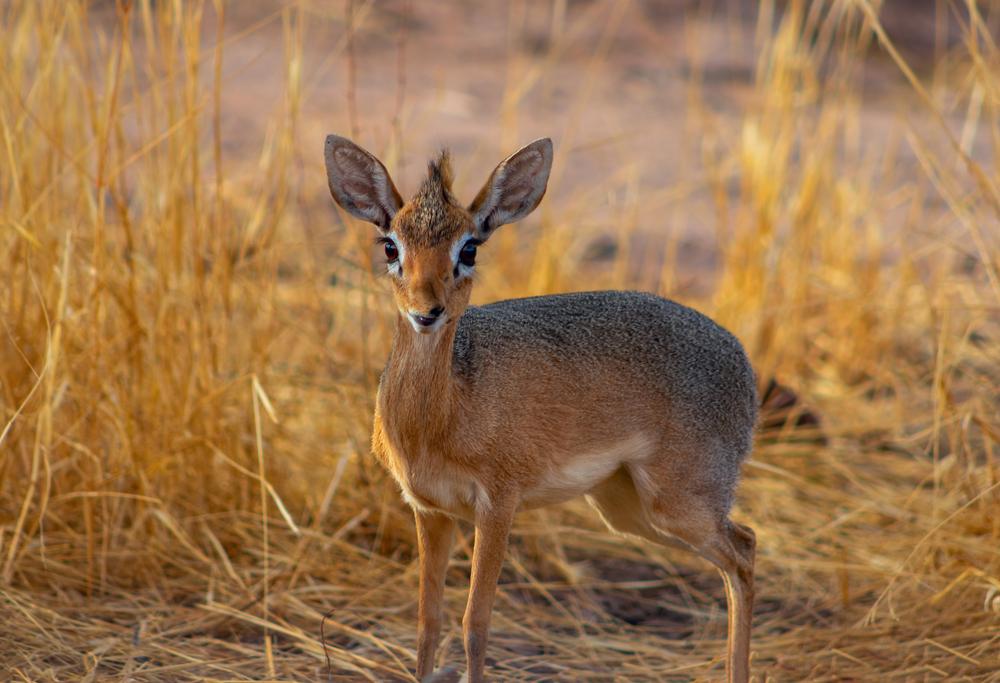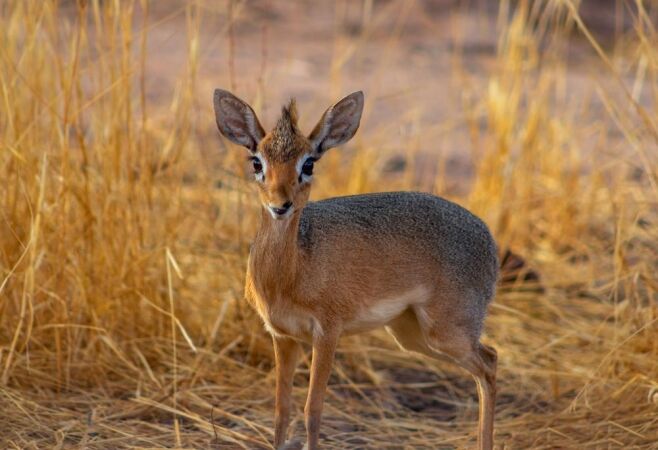

The Damara dik-dik (Madoqua kirkii) is a popular member of the Tiny 10 and is often targeted on a game hunting safari in Namibia. Also known as Kirk’s dik-dik, these small antelopes are found in two African regions. Firstly, they inhabit East Africa, from southern Somalia to central Tanzania and they are also found in southern Africa from northern Namibia and parts of southwestern Angola. They are a protected species but can be hunted with a special permit when game hunting in Namibia.
This antelope is extremely shy and cautious. They prefer habitats of dense thickets and shrubs that provide closed canopy cover and even rocky areas with little grass coverage. The Damara dik-dik’s choice of habitat not only allows them shade and protection from the weather but also provides areas in which to hide from predators. They are very wary and will dive for cover at the first sign of perceived danger or threats.
Damara dik-diks are nocturnal herbivores and forage for food at night. They survive on leaves, berries, fruit, herbs, shoots, and succulent plants that are water-rich. They are quite adaptable in terms of habitat as they live in the shrublands and savannas and can survive in many conditions, provided that there is lots of cover and edible plants and fruits to eat. They are water-independent, as their food intake provides sufficient moisture and this allows them to live in small territories that remain constant and stable. This in turn gives them a great advantage over any predators, as they know their territories well and can run up to 26 miles per hour to escape them.
Damara dik-diks are monogamous and live in pairs. The gestation period is 5-6 months, resulting in the female being able to produce twice a year. One offspring is born weighing 1.1-1.8 pounds and it remains hidden for the first 2-3 weeks of its life.
As a member of Africa’s Tiny Ten, the Damara dik-dik is a sought-after trophy for specialized Africa plains game hunting in Namibia. They fall prey to many predators such as hyenas, leopards, cheetahs, caracals, jackals, baboons, eagles, pythons, and many other members of the cat family.
Name:
Madoqua Kirkii
Weight:
6-16 pounds
Shoulder Height:
21 inches
Range:
Southern and East Africa
Mating Season:
Throughout the year
Life span:
10 years
Hunting the Damara Dik-Dik Requires a permit for a hunting safari in Namibia
When enjoying specialized plains game hunting in Namibia and targeting the Damara Dik-Dik, you will need to be very focused and alert! These minute antelopes only stand 12–15.5 inches at the shoulder, are 19.5–27.5 inches in length and adults weigh 6.6–13.2 pounds. Keep those eyes peeled! They vary in color depending on their habitat but they are typically a yellow-gray to reddish-brown color on their back, with a white to off-white belly. Only the males have horns that can grow just more than 3 inches. Their horns are often obscured by the little tuft of hair on their foreheads.
When on a game hunting safari in Namibia, there are three main methods of hunting the Damara dik-dik. The first method to successfully complete an African plains game hunting safari for the Damara dik-dik is to locate the pile of dung where the animal usually defecates. As these antelopes are nocturnal, this would usually be done in the early morning or late afternoon, when the Damara dik-diks set out in search of food. The second method involves driving through an area where the dung pile is, keeping a lookout for them, and taking a shot as you spot them. The third method when hunting the Damara dik-dik in Namibia is walking and stalking an area where they have been seen. Keep your eyes close to the ground, as they crouch in vegetation to avoid danger and threats. Should you see one and miss your opportunity, keep your wits about you as they typically travel in pairs and luck may just be on your side to catch the other antelope!
It must be stressed that this Damara dik-dik hunt is a challenging game hunting experience for the hunter to test their skills of observation, as these antelopes are extremely adept at camouflaging themselves within natural vegetation. Keep an eye out for horns, as this would indicate the male of the species. When on a hunting safari in Namibia, remember that it’s not only about the trophy but also the hunt itself. The hunter versus the prey, the sheer adrenaline from the first time you spotted the animal right through to when you took the shot and completed your hunting safari, will forever be etched in your memory. Take your time, take your shot but store those memories too.
When it comes to Damara dik-dik hunting in Namibia, any of the small calibers from the 6mm to .243 Winchester calibers will do. A .22 hornet is a perfect choice. Larger calibers can be used with a light solid bullet if the kinetic energy is minimal, thereby avoiding damage to the trophy.
Search from our range of Hunts across various popular destinations in Africa.
Find A Hunt